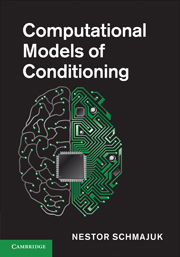Book contents
- Frontmatter
- Contents
- List of contributors
- Introduction
- 1 Evolution of attention in learning
- 2 The arguments of associations
- 3 The hybrid modeling approach to conditioning
- 4 Within-compound associations: models and data
- 5 Associative modulation of US processing: implications for understanding of habituation
- 6 Attention, associations, and configurations in conditioning
- 7 Computer simulation of the cerebellum
- 8 The operant/respondent distinction: a computational neural-network analysis
- Index
- References
5 - Associative modulation of US processing: implications for understanding of habituation
Published online by Cambridge University Press: 10 January 2011
- Frontmatter
- Contents
- List of contributors
- Introduction
- 1 Evolution of attention in learning
- 2 The arguments of associations
- 3 The hybrid modeling approach to conditioning
- 4 Within-compound associations: models and data
- 5 Associative modulation of US processing: implications for understanding of habituation
- 6 Attention, associations, and configurations in conditioning
- 7 Computer simulation of the cerebellum
- 8 The operant/respondent distinction: a computational neural-network analysis
- Index
- References
Summary
Abstract
Considerable data from Pavlovian conditioning indicate that events that are associatively signaled by discrete cues are not as effectively processed as they otherwise would be. Extrapolating from early evidence of this phenomenon, especially so-called conditioned diminution of the unconditioned response (CDUR), Wagner (1976, 1979) suggested that a similar effect might be responsible for long-term habituation, as stimuli come to be “expected” in the context in which they have been exposed. In this paper we will reflect upon this reasoning in the light of more recent evidence from our laboratory and elsewhere. One major complication is that extended contexts (as well as discrete cues) can control response-potentiating, conditioned-emotional tendencies, in addition to the presumed decremental effects. Experiments that separate these effects will be exemplified, and one theoretical approach, through the models SOP and AESOP (Wagner, 1981; Wagner & Brandon, 1989) will be illustrated, with some implications for our further understanding of habituation.
In the late 1970s, Wagner (1976; 1979) presented some views about associative learning that were centered upon the notion that events that are already represented, or “primed” in active memory, are not as effectively processed as they otherwise would be. One of several forms of evidence for this supposition was the so-called conditioned diminution of the UR, a phenomenon originally reported by Kimble and Ost (1961), in the context of human eyeblink conditioning.
- Type
- Chapter
- Information
- Computational Models of Conditioning , pp. 150 - 185Publisher: Cambridge University PressPrint publication year: 2010
References
- 2
- Cited by



